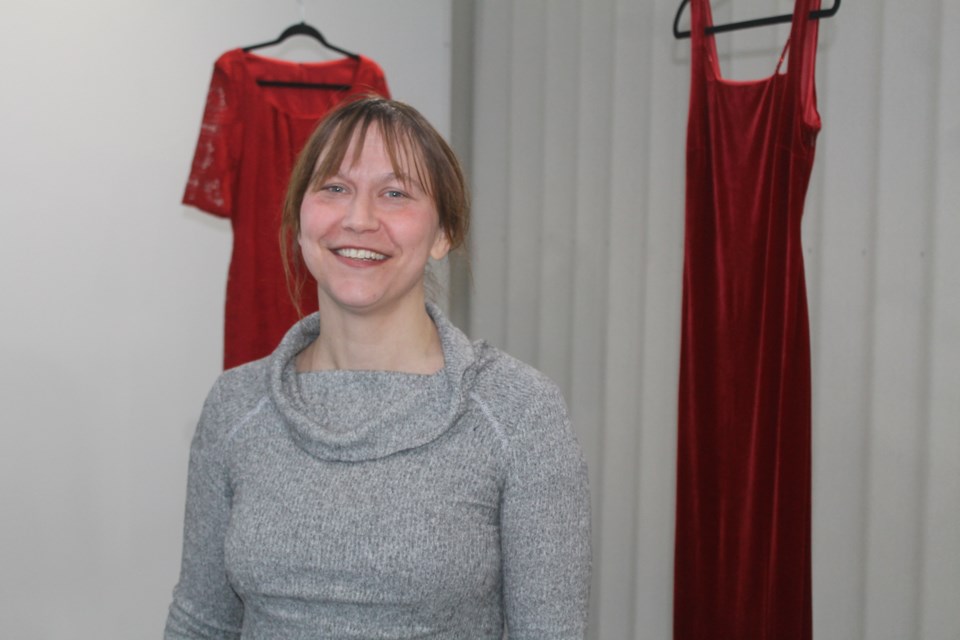MELFORT— Jaime Black, the creator of the red dress project, spoke about red dress displays being defaced, answering an audience question, following it happening in Nipawin.
“I think that when actions like that happen, we really get to see what’s happening,” she said.
“It sort of brings forward what’s really going on underneath the surface in people’s minds in our communities, and I think it’s really a potential for a learning opportunity and creating a space for having conversations about why we’re talking about Indigenous women and not all women. Of course all human life is valuable and important, but Indigenous women specifically are being targeted through these colonial systems in a way white women aren’t. ”
Black visited the region during the Melfort’s annual Missing and Murdered Indigenous Women and Girls conference on March 10.
First started in 2009, the red dresses are an installation art project designed to draw attention to missing and murdered Indigenous women and girls.
Black said that while the dresses are a commemoration project, they are also a call to action.
“The idea of the dresses is to get people learning about what’s going on if they don’t know, but also to get active and change how they relate to people, and break down these barriers created by racism and colonialism.”
An example of the barriers includes a low response time by the RCMP when investigating missing Indigenous women and girls.
“I heard from a family that they called about their missing daughter, and the police told them, ‘they don’t do family reunions’ and hung up the phone on them.”
Glenda Yuzicappi knows this personally. Her daughter, Amber Redman went missing in 2005.
Yuzicappi told her daughter’s story at the conference.
“I did face the delay with the police,” she said.
“Not only the police, the media… She wasn’t a priority. If it was a non-First Nations woman they would have been out there. I see it in the public’s view, I see it happening.”
Redman went missing on a Thursday. Yuzicappi said that due to her own panic and denial she delayed contacting the police until Monday. Even then, Yuzicappi feels the police delayed the search further, not starting an active search until the family initiated one Wednesday.
“I phoned the police Wednesday morning and then I said ‘we’re starting a search’ and that’s when they came on board.”
Yuzicappi said the issue is still continuing today. She advocates all women learn self-defensive, go in a buddy system, and let people know when they’re leaving.
“Our women are still in danger from being taken, being abducted and I will continue to share my daughter’s story. If it can help one person, then that’s my purpose for today,” Yuzicappi said.
“Always be observant of your area and where you’re at— the parking lot, anywhere, grocery store, movie theatre— anywhere. People, men and even women can take you.”
According to Statistics Canada, nine per cent of female homicide victims in 1980 were Indigenous. By 2015, Indigenous women made up 24 per cent of homicide victims in Canada. This was noted in the federal government’s 2018 interim report for the National Inquiry into Murdered and Missing Indigenous Women and Girls.
The 2018 interim report shows that while homicide rates for non-Indigenous women have gone down over the decades, homicide rates for Indigenous women have been going up. Indigenous women are 12 times more likely to be murdered or missing than any other women in Canada, and 16 times more likely than Caucasian women.
In Manitoba or Saskatchewan, they are 19 more times likely than Caucasian women to be murdered or missing.
“It’s on a street level, people are facing racism on a day to day basis still in our country, but it’s also in the institutions,” Black said.
“The voices of Indigenous people are not being brought to the forefront and there’s no space for Indigenous voices to be heard.”
Black said often times being an ally is thought of as overcomplicated.
“It can be as simple as really showing care and compassion to each other on a day to day basis and really reaching out to people when you feel like they need support. It sounds trite and sort of cute or whatever, but it’s real. I think that showing care for each other is a really powerful way of fighting against these systems that are trying to tear us down.”
During the conference, Black also discussed the Wet'suwet'en First Nation in British Columbia, whose matriarchs were arrested in an RCMP raid—after the women refused to leave their land for a pipeline to be built.
Black said to be an ally means being present in fighting alongside Indigenous people and protecting the land and water.
“It’s really an opportunity for non-Indigenous people to show their care for not just Indigenous culture but also the land they live on and I think we get really political with all these stuff. Yes it is political, but with me I just go back to what I stand for and what’s important to me living on this land,” she said
“That’s protecting the land and making sure it’s able to provide for generations to come, and not abused through industry.”
Black said it can be a scary time for Indigenous people, as the more the community stands up and speaks out the more racist backlash there is.
“There’s a lot of pushback towards us speaking out, but I think if we do that together hopefully we can remain as safe as possible as we stand up and do this work.”




